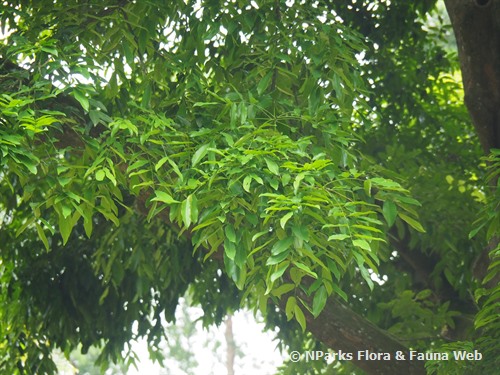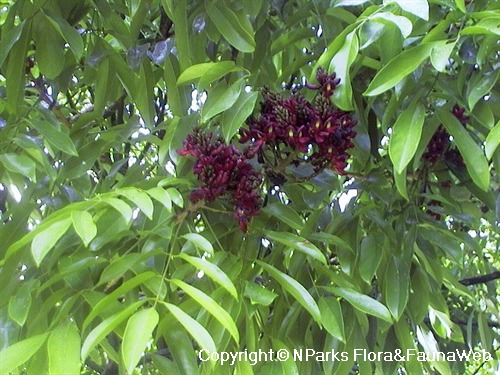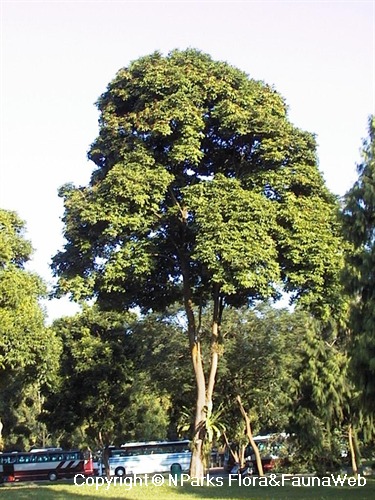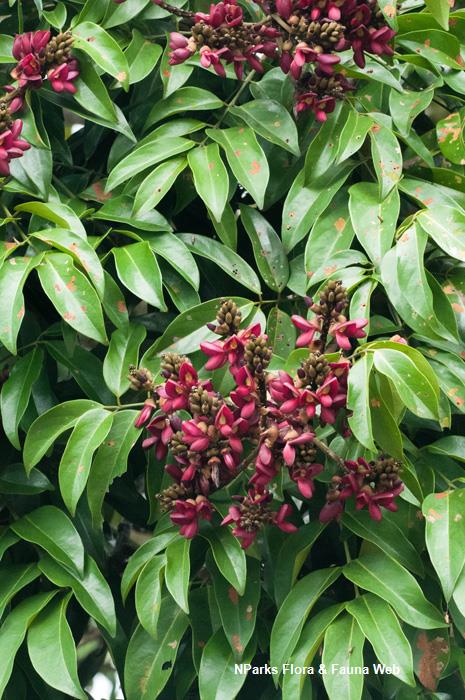
Back
Adinobotrys atropurpureus (Wall.) Dunn
| Family Name: | Fabaceae (Leguminosae) |
| Synonyms: | Callerya atropurpurea (Wall.) Schot, Millettia atropurpurea (Wall.) Benth., Millettia paniculata Miq., Pongamia atropurpurea Wall., Whitfordiodendron atropurpureum (Wall.) Dunn, Whitfordiodendron pubescens (Craib) Burkill |
| Common Name: | Tulang Daing, Purple Millettia, Jenaris, Jenerek, Tulang Dain |
Name
Classifications and Characteristics
| Plant Division | Angiosperms (Flowering Seed Plants) (Dicotyledon) |
|---|---|
| Plant Growth Form | Tree |
| Lifespan (in Singapore) | Perennial |
| Mode of Nutrition | Autotrophic |
| Plant Shape | Umbrella |
| Maximum Height | 30 m |
| Tree or Palm – Trunk Diameter | 5 m to 6 m |
Biogeography
| Native Distribution | West Malaysia, Sumatra, Laos, Myanmar, Thailand |
|---|---|
| Preferred Climate Zone | Tropical |
| Local Conservation Status | Non-native (Spontaneous (Naturalised)) |
Description and Ethnobotany
| Growth Form | Large evergreen tree with a thick, umbrella-shaped or round crown. |
|---|---|
| Trunk | Tall trunk with light grey, shallowly cracked bark. |
| Foliage | Pinnately compound leaves with 3 - 5 pairs of large, elliptic leaflets. Leaves are smooth and glossy with entire leaf margins. |
| Flowers | Asymmetrical, bisexual flowers have red to purple petals. Petals are cup-shaped and overlap one another with the larger petal held above the smaller. Flowers release an unpleasant aroma. Inflorescence is a panicle in which several spike inflorescences branch off a main axis. It is located near the branch tips. |
| Fruit | Dehiscent, dry fruits are dark brown pods. Oblong, woody pods have curved, pointed tips (10 - 15 cm long). Each pod produces 1 - 2 brown oval seeds (7 cm long). |
| Others - Plant Morphology | Landscaping: This species produces an abundance of reddish purple flowers. It is ideal as a focal plant for parks. It is planted along roadsides in Singapore. One drawback is the litter produced from its seed pods and seeds. Propagation: Propagate by seed and stem cuttings. Etymology: The species epithet "atropurpureus" comes from the Latin words for black ("ater") and purple ("purpureus"). The reference is to the dark purple flowers. |
| Ethnobotanical Uses | Edible Plant Parts : Edible Leaves Cultural / Religious: Heritage Tree : There are currently one individuals of Callerya atropurpurea listed as Heritage Trees in Singapore. To find out more about the heritage tree, please visit the Heritage Tree Register. Others: Food: Young leaves are edible. |
Landscaping Features
| Desirable Plant Features | Ornamental Flowers, Fragrant (Flowers) (Day) |
|---|---|
| Landscape Uses | Shade Providing Tree / Palm, Focal Plant |
Fauna, Pollination and Dispersal
| Seed or Spore Dispersal | Abiotic (Gravity) |
|---|
Plant Care and Propagation
| Light Preference | Full Sun |
|---|---|
| Water Preference | Moderate Water |
| Plant Growth Rate | Moderate |
| Rootzone Tolerance | Fertile Loamy Soils, Well-Drained Soils |
| Propagation Method | Seed, Stem Cutting |
Foliar
| Mature Foliage Colour(s) | Green |
|---|---|
| Mature Foliage Texture(s) | Smooth, Glossy / Shiny |
| Foliar Type | Compound (Odd-Pinnate) |
| Foliar Shape(s) | Non-Palm Foliage (Elliptical) |
| Foliar Venation | Pinnate / Net |
| Foliar Margin | Entire |
| Foliar Apex - Tip | Acute |
| Foliar Base | Acute |
| Leaf Area Index (LAI) for Green Plot Ratio | 4.0 (Tree - Dense Canopy) |
Non - Foliar and Storage
| Trunk Type (Non Palm) | Woody |
|---|---|
| Bark Colour(s) | Light grey |
| Mature Bark Texture | Smooth |
| Root Type | Underground (Tap Root) |
Floral (Angiosperm)
| Flower & Plant Sexuality | Bisexual Flowers |
| Flower Colour(s) | Purple, Red |
|---|---|
| Flower Symmetry | Asymmetrical |
| Inflorescence Type | Panicle |
| Flowering Habit | Polycarpic |
Fruit, Seed and Spore
| Mature Fruit Colour(s) | Brown |
|---|---|
| Fruit Classification | Simple Fruit |
| Fruit Type | Dehiscent Dry Fruit , Legume / Pod |
Image Repository
Others
| Master ID | 1476 |
|---|---|
| Species ID | 2769 |
| Flora Disclaimer | The information in this website has been compiled from reliable sources, such as reference works on medicinal plants. It is not a substitute for medical advice or treatment and NParks does not purport to provide any medical advice. Readers should always consult his/her physician before using or consuming a plant for medicinal purposes. |

_lowres.jpg)
_lowres.jpg)
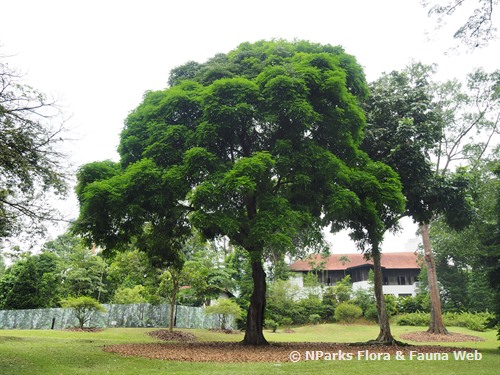
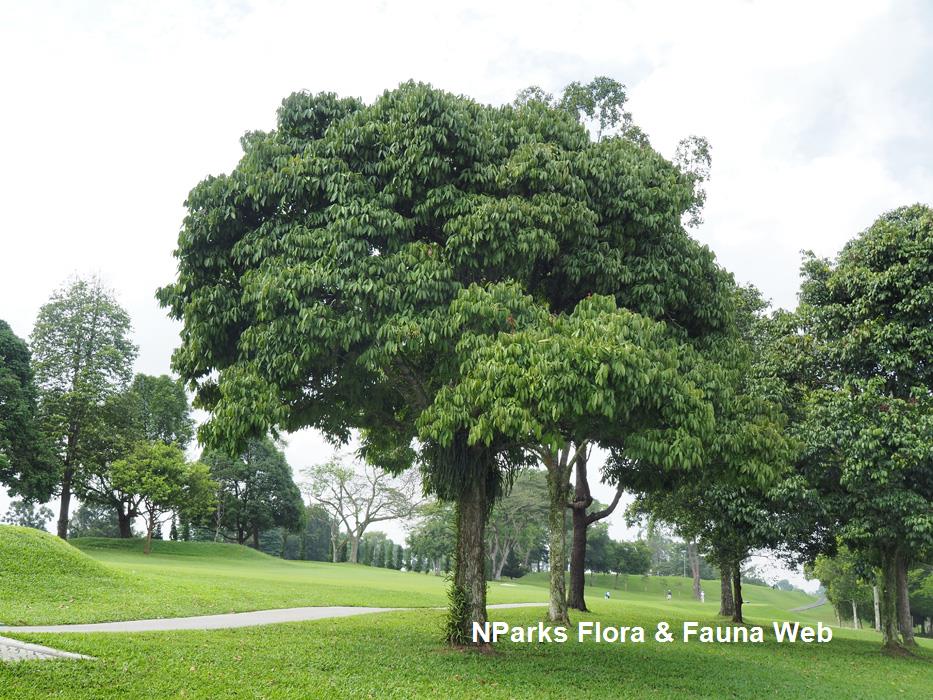
_lowres.jpg)
